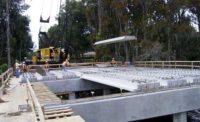
Smart vehicles, stupid infrastructure—that’s a phrase often invoked by Ted Zoli, national bridge chief engineer for HNTB, when he talks about the advent of connected vehicles that communicate with each other. He asks, will smart vehicles communicate with infrastructure? And will future infrastructure communicate with engineers?
The answer is yes, he predicts. Further, he designed a test bed, the Memorial Bridge, which runs over the Piscataqua River between New Hampshire and Maine. The 1,200-ft-long, two-year-old bridge is becoming a “living bridge”—a piece of self-diagnosing, self-reporting smart infrastructure studded with about 250 sensors. The array will monitor traffic, vibration, stress, temperature, wind, humidity and precipitation as well as water quality, turbidity and the effects of any ship impacts. It will be powered by a tidal energy turbine on a bridge pier.
The $355,000 project, launched by University of New Hampshire assistant professor Erin Bell, expands on a National Science Foundation effort with the New Hampshire DOT, the Maine DOT and the Federal Highway Administration, which is funding the project.
Engineers are keen to see the data. Zoli’s design includes unusual gusset-less truss connections, a structural metalized steel coating and a vertical-lift balance system. The data that accumulates over the next three years may influence future use of similar designs.
“Getting some of the stresses on that new [gusset-less] connection area is important,” says L. Robert Landry Jr., consulting design chief for NHDOT. Noting that truss bridges with hard-to-maintain gusset plates fell under intense scrutiny after Minneapolis’ I-35W bridge collapse, he says if the gusset-less connection performs well, “it will move a long way to trusses coming back into favor.”



